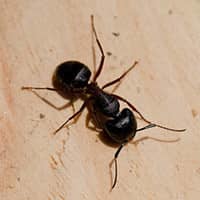We find in the world of pests that there are some pests that are a major nuisance—they just irritate us to no end. And then there are other pests that take it to another level. Those pests fall into another category—destructive pests! For example, the tiny pavement ant is a nuisance while the carpenter ant is a destructive insect.
The carpenter ant has the clear distinction of being among the largest of all ants in the United States. They can be found nesting both inside and outdoors. Their favorite habitat is moist, decaying wood. The carpenter ant has huge, powerful mandibles. These powerful jaws are used to bite into wood as they burrow inside the structural components of your home. The shavings and sawdust particles are removed, leaving a nice, clean nest. The carpenter ant does not actually eat the wood. They just destroy it by burrowing into the wood and creating tunnels and galleries. The choice diet of the carpenter ant is similar to that of humans. They eat a variety of food ranging from sweets to meats. In addition to people food, the carpenter ant will also feed on other insects.
While the carpenter ant doesn’t eat wood like termites, they create damage with their excavation services. A large colony can cause an incredible amount of damage over a period of time with their extensive network of tunnels and galleries. These nests will sometimes contain upwards of several thousand ants.
The carpenter ant usually starts out in an area where the wood is damaged from water or heavy moisture. Another attractant to the carpenter ant is decaying wood. However, once they begin in an area of water-damaged wood, they expand their tunnels and end up burrowing into solid wood. This process continues as the colony grows until the structural integrity and strength of the building is compromised. The carpenter ant has also been known to move into brand new buildings and build nests. This usually occurs in areas where the surrounding land has been cleared and the nest is disturbed, driving the ants indoors.
While the potential damage from carpenter ants is serious enough to always call on your pest control professionals for eradication, there are some tips that homeowners can employ. These tips, when followed, will greatly reduce the risk of an infestation of carpenter ants.
- Prevention begins by sealing off all points of entry. This includes utility line entrances as well as any gaps around windows and doors.
- Repair or replace any clogged gutters or leaking pipes that may keep the wood damp and decaying.
- Cut all tree branches and shrubbery away from the house to keep ants from accessing the building.
- Ensure adequate ventilation in crawl spaces and attics to reduce dampness.
- Keep a clean kitchen and remove all potential food sources. Store leftovers and pantry supplies in pest proof containers.
Carpenter ants are not only destructive, they are extremely hard to eradicate. The parent colony must be located and destroyed. Finding and destroying smaller satellite colonies inside the home does not completely take care of the problem. The parent colony will continue to infest the home. Contact Big Blue Bug Solutions today for a free quote on our highly successful carpenter ant control techniques.

